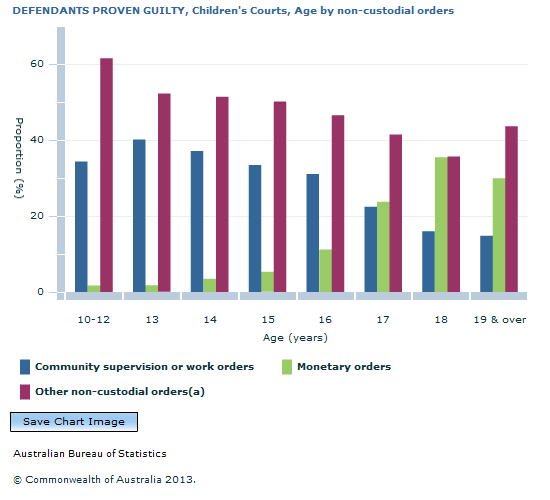4513.0 - Criminal Courts, Australia, 2011-12  Quality Declaration
Quality Declaration
ARCHIVED ISSUE Released at 11:30 AM (CANBERRA TIME) 14/02/2013
Page tools:
 Print Page Print Page
 Print All Print All
| ||||
SENTENCE OUTCOMES Sentence refers to the principal sentence a proven guilty defendant receives from the court (refer to Explanatory Notes paragraphs 45-48 for further information). Differences in sentencing result from the offence with which the defendant was proven guilty, as well as a range of aggravating and mitigating factors taken into account by the court, such as prior convictions, level of violence, whether the offender can successfully claim provocation was involved, and demonstrations of remorse. The range of sentences available also differs across states and territories. Custodial orders Of defendants proven guilty in the Children's Courts in 2011-12, 2,836 (11%) were sentenced to custodial orders. Of all guilty defendants, 6% were sentenced to custody in a correctional institution, while defendants sentenced to custody in the community accounted for 2% and those with fully suspended sentences accounted for 3%. The proportion of defendants proven guilty receiving a custodial order varied across states and territories. The Northern Territory (21%), Tasmania (15%) and New South Wales (14%) had the highest proportions of defendants receiving a custodial order. Queensland and Western Australia had the lowest proportion (both 7%).  Source(s): Criminal Courts, Australia The offence with the highest proportion of custodial sentences was robbery and extortion (36% or 381 defendants). Most of these defendants were sentenced to custody in a correctional institution.  Source(s): Criminal Courts, Australia Custodial orders were issued to 12% of guilty male defendants and 5% of guilty female defendants. Defendants aged 17 years were the most likely to receive a sentence of custody in a correctional institution (7% or 473 defendants). Those aged 10 to 12 years were the least likely (1%) to receive a sentence of custody in a correctional institution. Non-custodial orders During 2011-12, 89% (23,689) of defendants proven guilty in the Children's Courts were sentenced to non-custodial orders. Of guilty defendants, 28% received a sentence of community supervision or work orders, while 15% received a principal sentence of a monetary order. Defendants proven guilty of robbery and extortion were most likely to be issued with a community supervision or work order (49%) followed by unlawful entry with intent (47%), homicide (46%) and sexual assault (44%). Defendants proven guilty of traffic offences were most likely to be issued with a monetary order (53%), followed by miscellaneous offences (47%) and dangerous or negligent acts (38%).  Footnote(s): (a) Includes good behaviour bonds, licence disqualification/suspensions/amendments, forfeiture or property and nominal penalties. Source(s): Criminal Courts, Australia Of the 20,954 male defendants proven guilty, over one-quarter (29%) received a community supervision or work order, while 16% received a monetary order. Sentences for female defendants were similar to males: 26% received a community supervision or work order and 14% received a monetary order. The proportion of defendants receiving community supervision or work orders generally decreased with age, from 40% of 13 year old defendants to 15% of those aged 19 years and over. Older defendants were more likely to be sentenced to monetary orders: 33% of those aged 18 years and over received this order compared to 2% of 10 to 12 year olds.  Footnote(s): (a) Includes good behaviour bonds, licence disqualification/suspensions/amendments, forfeiture or property and nominal penalties. Source(s): Criminal Courts, Australia
|
||||
